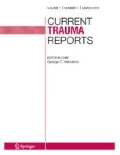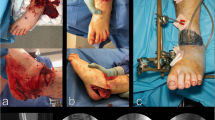Abstract
Purpose of the Review
To provide a comprehensive overview of care and rehabilitation of those with traumatic limb loss, from preoperative to lifelong care.
Recent Findings
Comprehensive care including peer support and monitoring for the development of secondary conditions which compound disability is essential after traumatic amputation. Conditions that commonly develop after traumatic limb loss include heterotopic ossification, intact limb knee osteoarthritis, low back pain, and reduction in cardiopulmonary reserve.
Summary
Optimal care for people after traumatic limb loss requires a multidisciplinary team to provide perioperative and lifelong care. In addition to ensuring optimal rehabilitation based on the individual’s vocational and avocational goals, current function, concomitant injuries, and amputation level, their psychological recovery must not be overlooked. To optimize quality of life and independence, lifelong follow-up with a physiatrist is essential to care for complications and secondary conditions, as well as to promote an active lifestyle.




Similar content being viewed by others
References
Papers of particular interest, published recently, have been highlighted as: • Of importance
Dillingham TR, Pezzin LE, MacKenzie EJ. Incidence, acute care length of stay, and discharge to rehabilitation of traumatic amputee patients: an epidemiologic study. Arch Phys Med Rehabil. 1998;79(3):279–87.
Higgins TF, Klatt JB, Beals TC. Lower extremity assessment project (LEAP)--the best available evidence on limb-threatening lower extremity trauma. Orthop Clin North Am. 2010;41(2):233–9. https://doi.org/10.1016/j.ocl.2009.12.006.
Doukas WC, Hayda RA, Frisch HM, Andersen RC, Mazurek MT, Ficke JR, et al. The military extremity trauma amputation/limb salvage (METALS) study: outcomes of amputation versus limb salvage following major lower-extremity trauma. J Bone Joint Surg Am. 2013;95(2):138–45. https://doi.org/10.2106/JBJS.K.00734.
Krueger CA, Rivera JC, Tennent DJ, Sheean AJ, Stinner DJ, Wenke JC. Late amputation may not reduce complications or improve mental health in combat-related, lower extremity limb salvage patients. Injury. 2015;46(8):1527–32. https://doi.org/10.1016/j.injury.2015.05.015.
Rauh MJ, Aralis HJ, Melcer T, Macera CA, Sessoms P, Bartlett J, et al. Effect of traumatic brain injury among U.S. servicemembers with amputation. J Rehabil Res Dev. 2013;50(2):161–72.
Ficke JR. Transtibial amputation: surgical management. In: Krajbich JI, Pinzur MS, Potter BK, Stevens PM, editors. Atlas of amputations and limb deficiencies: surgical, prosthetic, and rehabilitation principles. 4th ed. Rosemont, IL: American Academy of Orthopaedic Surgeons; 2016. p. 485–91.
Tintle SM, Keeling JJ, Shawen SB, Forsberg JA, Potter BK. Traumatic and trauma-related amputations: part I: general principles and lower-extremity amputations. J Bone Joint Surg Am. 2010;92(17):2852–68. https://doi.org/10.2106/JBJS.J.00257.
Gottschalk F. Transfemoral amputation: surgical management. In: Krajbich JI, Pinzur MS, Potter BK, Stevens PM, editors. Atlas of amputations and limb deficiencies: surgical, prosthetic, and rehabilitation principles. 4th ed. Rosemont, IL: American Academy of Orthopaedic Surgeons; 2016. p. 525–35.
Behr J, Friedly J, Molton I, Morgenroth D, Jensen MP, Smith DG. Pain and pain-related interference in adults with lower-limb amputation: comparison of knee-disarticulation, transtibial, and transfemoral surgical sites. J Rehabil Res Dev. 2009;46(7):963–72.
Nanos GP III. Wrist disarticulation and Transradial amputation: surgical management. In: Krajbich JI, Pinzur MS, Potter BK, Stevens PM, editors. Atlas of amputations and limb deficiencies: surgical, prosthetic, and rehabilitation principles. 4th ed. Rosemont, IL: American Academy of Orthopaedic Surgeons; 2016. p. 221–31.
Cho MS. Elbow disarticulation and Transhumeral amputation: surgical management. In: Krajbich JI, Pinzur MS, Potter BK, Stevens PM, editors. Atlas of amputations and limb deficiencies: surgical, prosthetic, and rehabilitation principles. 4th ed. Rosemont, IL: American Academy of Orthopaedic Surgeons; 2016. p. 249–55.
• Reichmann JP, Bartman KR. An integrative review of peer support for patients undergoing major limb amputation. J Vasc Nurs. 2018;36(1):34–9. https://doi.org/10.1016/j.jvn.2017.10.002This review article, while drawing from limited published evidence, supports the integration of pre- and post-operative peer visitors for people with major limb amputation.
Krueger CA, Wenke JC. Initial injury severity and social factors determine ability to deploy after combat-related amputation. Injury. 2014;45(8):1231–5. https://doi.org/10.1016/j.injury.2014.02.008.
Webster JB, Poorman CE, Cifu DX. Guest editorial: Department of Veterans Affairs Amputations System of care:5 years of accomplishments and outcomes. J Rehabil Res Dev. 2014;51(4):vii–xvi. https://doi.org/10.1682/JRRD.2014.01.0024.
Butler K, Bowen C, Hughes AM, Torah R, Ayala I, Tudor J, et al. A systematic review of the key factors affecting tissue viability and rehabilitation outcomes of the residual limb in lower extremity traumatic amputees. J Tissue Viability. 2014;23(3):81–93. https://doi.org/10.1016/j.jtv.2014.08.002.
Meroni R, Beghi E, Beghi M, Brambilla G, Cerri C, Perin C, et al. Psychiatric disorders in patients suffering from an acute cerebrovascular accident or traumatic injury, and their effects on rehabilitation: an observational study. Eur J Phys Rehabil Med. 2013;49(1):31–9.
Mckechnie PS, John A. Anxiety and depression following traumatic limb amputation: a systematic review. Injury. 2014;45(12):1859–66. https://doi.org/10.1016/j.injury.2014.09.015.
Bhatnagar V, Richard E, Melcer T, Walker J, Galarneau M. Lower-limb amputation and effect of posttraumatic stress disorder on Department of Veterans Affairs outpatient cost trends. J Rehabil Res Dev. 2015;52(7):827–38. https://doi.org/10.1682/JRRD.2014.11.0288.
Foote CE, Kinnon JM, Robbins C, Pessagno R, Portner MD. Long-term health and quality of life experiences of Vietnam veterans with combat-related limb loss. Qual Life Res. 2015;24(12):2853–61. https://doi.org/10.1007/s11136-015-1029-0.
Wegener ST, Mackenzie EJ, Ephraim P, Ehde D, Williams R. Self-management improves outcomes in persons with limb loss. Arch Phys Med Rehabil. 2009;90(3):373–80. https://doi.org/10.1016/j.apmr.2008.08.222.
Yazicioglu K, Yavuz F, Goktepe AS, Tan AK. Influence of adapted sports on quality of life and life satisfaction in sport participants and non-sport participants with physical disabilities. Disabil Health J. 2012;5(4):249–53. https://doi.org/10.1016/j.dhjo.2012.05.003.
Laferrier JZ, Teodorski E, Cooper RA. Investigation of the impact of sports, exercise, and recreation participation on psychosocial outcomes in a population of veterans with disabilities: a cross-sectional study. Am J Phys Med Rehabil. 2015;94(12):1026–34. https://doi.org/10.1097/PHM.0000000000000263.
Wetterhahn KA, Hanson C, Levy CE. Effect of participation in physical activity on body image of amputees. Am J Phys Med Rehabil. 2002;81(3):194–201.
Biddis EA, Chau TT. Upper limb prosthesis use and abandonment: a survey of the last 25 years. Prosthetics Orthot Int. 2007;31(3):236–57. https://doi.org/10.1080/03093640600994581.
Malone JM, Fleming LL, Roberson J, Whitesides TE, Leal JM, Poole JU, et al. Immediate, early, and late postsurgical management of upper-limb amputation. J Rehabil Res Dev. 1984;21(1):33–41.
Gaine WJ, Smart C, Bransby-Zachary M. Upper limb traumatic amputees. Review of prosthetic use. J Hand Surg Br. 1997;22(1):73–6.
• Keszler MS, Heckman JT, Kaufman GE, Morgenroth DC. Advances in prosthetics and rehabilitation of individuals with limb loss. Phys Med Rehabil Clin N Am. 2019;30(2):423–37. https://doi.org/10.1016/j.pmr.2018.12.013This review provides the most current update on advances in the field of prosthetics and amputation rehabilitation.
Knowlton LM, Gosney JE, Chackungal S, Altschuler E, Black L, Burkle FM, et al. Consensus statements regarding the multidisciplinary care of limb amputation patients in disasters or humanitarian emergencies: report of the 2011 humanitarian action summit surgical working group on amputations following disasters or conflict. Prehosp Disaster Med. 2011;26(6):438–48. https://doi.org/10.1017/S1049023X12000076.
Eikermann M, Velmahos G, Abbara S, Huang PL, Fagan SP, Hirschberg RE, et al. Case records of the Massachusetts General Hospital. Case 11-2014. A man with traumatic injuries after a bomb explosion at the Boston Marathon. N Engl J Med. 2014;370(15):1441–51. https://doi.org/10.1056/NEJMcpc1314240.
Hick JL, Hanfling D, Evans B, Greenberg D, Alson R, McKinney S, et al. Health and medical response to active shooter and bombing events. Washington, DC: National Academy of Medicine; 2016.
Gates JD, Arabian S, Biddinger P, Blansfield J, Burke P, Chung S, et al. The initial response to the Boston marathon bombing: lessons learned to prepare for the next disaster. Ann Surg. 2014;260(6):960–6. https://doi.org/10.1097/SLA.0000000000000914.
Crandell DM. 49th W. J. Zeiter lecture, the specialty of hope: how physiatry made Boston strong. PM R. 2018;10(5):533–7. https://doi.org/10.1016/j.pmrj.2018.03.010.
Edwards DS, Kuhn KM, Potter BK, Forsberg JA. Heterotopic ossification: a review of current understanding, treatment, and future. J Orthop Trauma. 2016;30(Suppl 3):S27–30. https://doi.org/10.1097/BOT.0000000000000666.
• Cannon JW, Hofmann LJ, Glasgow SC, Potter BK, Rodriguez CJ, Cancio LC, et al. Dismounted complex blast injuries: a comprehensive review of the modern combat experience. J Am Coll Surg. 2016;223(4):652–64.e8. https://doi.org/10.1016/j.jamcollsurg.2016.07.009Review of the dismounted complex blast injuries, which have increased due to recent conflicts, describing the outcomes, challenging treatment, and complications of these injuries.
Shehab D, Elgazzar AH, Collier BD. Heterotopic ossification. J Nucl Med. 2002;43(3):346–53.
Pavey GJ, Polfer EM, Nappo KE, Tintle SM, Forsberg JA, Potter BK. What risk factors predict recurrence of heterotopic ossification after excision in combat-related amputations? Clin Orthop Relat Res. 2015;473(9):2814–24. https://doi.org/10.1007/s11999-015-4266-1.
• Farrokhi S, Mazzone B, Eskridge S, Shannon K, Hill OT. Incidence of overuse musculoskeletal injuries in military service members with traumatic lower limb amputation. Archives of Physical Medicine and Rehabilitation. 2018;99:348–54. https://doi.org/10.1016/j.apmr.2017.10.010This study examined the rate of upper and lower limb overuse injuries, as well as low back pain, after traumatic unilateral and bilateral lower extremity amputations.
Morgenroth DC, Gellhorn AC, Suri P. Osteoarthritis in the disabled population: a mechanical perspective. PM R. 2012;4(5 Suppl):S20–7. https://doi.org/10.1016/j.pmrj.2012.01.003.
Struyf PA, van Heugten CM, Hitters MW, Smeets RJ. The prevalence of osteoarthritis of the intact hip and knee among traumatic leg amputees. Arch Phys Med Rehabil. 2009;90(3):440–6. https://doi.org/10.1016/j.apmr.2008.08.220.
Norvell DC, Czerniecki JM, Reiber GE, Maynard C, Pecoraro JA, Weiss NS. The prevalence of knee pain and symptomatic knee osteoarthritis among veteran traumatic amputees and nonamputees. Arch Phys Med Rehabil. 2005;86(3):487–93. https://doi.org/10.1016/j.apmr.2004.04.034.
Farrokhi S, Mazzone B, Yoder A, Grant K, Wyatt M. A narrative review of the prevalence and risk factors associated with development of knee osteoarthritis after traumatic unilateral lower limb amputation. Mil Med. 2016;181(S4):38–44. https://doi.org/10.7205/MILMED-D-15-00510.
Pruziner AL, Werner KM, Copple TJ, Hendershot BD, Wolf EJ. Does intact limb loading differ in servicemembers with traumatic lower limb loss? Clin Orthop Relat Res. 2014;472(10):3068–75. https://doi.org/10.1007/s11999-014-3663-1.
Morgenroth DC, Segal AD, Zelik KE, Czerniecki JM, Klute GK, Adamczyk PG, et al. The effect of prosthetic foot push-off on mechanical loading associated with knee osteoarthritis in lower extremity amputees. Gait Posture. 2011;34(4):502–7. https://doi.org/10.1016/j.gaitpost.2011.07.001.
Ehde DM, Smith DG, Czerniecki JM, Campbell KM, Malchow DM, Robinson LR. Back pain as a secondary disability in persons with lower limb amputations. Arch Phys Med Rehabil. 2001;82(6):731–4. https://doi.org/10.1053/apmr.2001.21962.
Friel K, Domholdt E, Smith DG. Physical and functional measures related to low back pain in individuals with lower-limb amputation: an exploratory pilot study. J Rehabil Res Dev. 2005;42(2):155–66.
Morgenroth DC, Orendurff MS, Shakir A, Segal A, Shofer J, Czerniecki JM. The relationship between lumbar spine kinematics during gait and low-back pain in transfemoral amputees. Am J Phys Med Rehabil. 2010;89(8):635–43. https://doi.org/10.1097/PHM.0b013e3181e71d90.
• Highsmith MJ, Goff LM, Lewandowski AL, Farrokhi S, Hendershot BD, Hill OT, et al. Low back pain in persons with lower extremity amputation: a systematic review of the literature. Spine J. 2019;19(3):552–63. https://doi.org/10.1016/j.spinee.2018.08.011Systematic review exploring different factors that potentially increase the risk of low back pain in people with lower limb amputations.
Buckley C, Buckley S. Do you really lose cardiopulmonary reserve after major amputation? JICC. 2016;6S:138–9.
Kurdibaylo SF. Cardiorespiratory status and movement capabilities in adults with limb amputation. J Rehabil Res Dev. 1994;31(3):222–35.
Modan M, Peles E, Halkin H, Nitzan H, Azaria M, Gitel S, et al. Increased cardiovascular disease mortality rates in traumatic lower limb amputees. Am J Cardiol. 1998;82(10):1242–7. https://doi.org/10.1016/s0002-9149(98)00601-8.
Peles E, Akselrod S, Goldstein DS, Nitzan H, Azaria M, Almog S, et al. Insulin resistance and autonomic function in traumatic lower limb amputees. Clin Auton Res. 1995;5(5):279–88.
Naschitz JE, Lenger R. Why traumatic leg amputees are at increased risk for cardiovascular diseases. QJM. 2008;101(4):251–9. https://doi.org/10.1093/qjmed/hcm131.
Vollmar JF, Paes E, Pauschinger P, Henze E, Friesch A. Aortic aneurysms as late sequelae of above-knee amputation. Lancet. 1989;2(8667):834–5. https://doi.org/10.1016/s0140-6736(89)92999-1.
Author information
Authors and Affiliations
Corresponding author
Ethics declarations
Conflict of Interest
The authors declare that they have no conflict of interest.
Human and Animal Rights and Informed Consent
This article does not contain any studies with human or animal subjects performed by any of the authors.
Additional information
Publisher’s Note
Springer Nature remains neutral with regard to jurisdictional claims in published maps and institutional affiliations.
This article is part of the Topical Collection on Amputations: From Injury To Rehabilitation
Rights and permissions
About this article
Cite this article
Keszler, M.S., Crandell, D.M. & Morgenroth, D.C. Rehabilitation of Individuals with Limb Loss due to Trauma. Curr Trauma Rep 6, 96–104 (2020). https://doi.org/10.1007/s40719-020-00193-8
Published:
Issue Date:
DOI: https://doi.org/10.1007/s40719-020-00193-8




